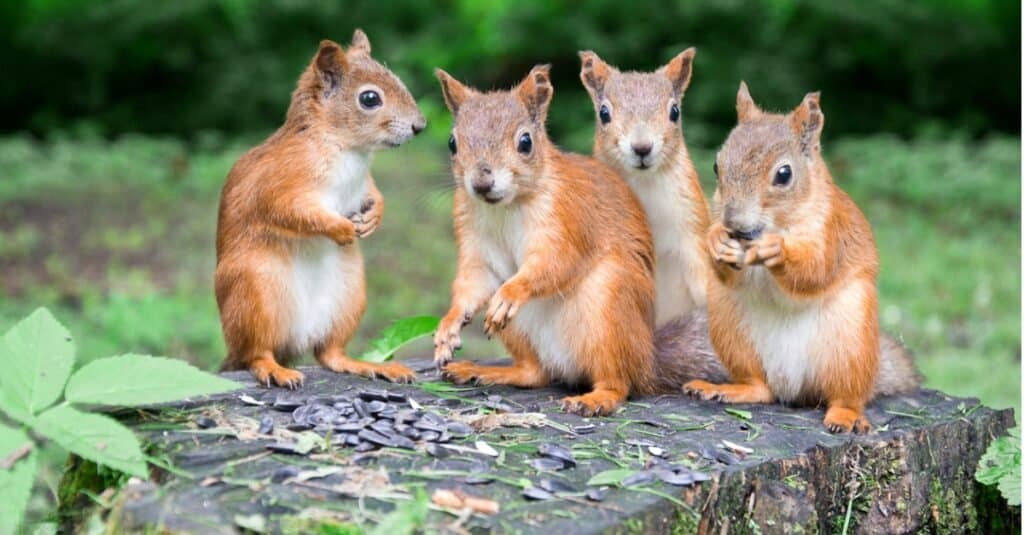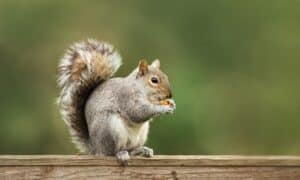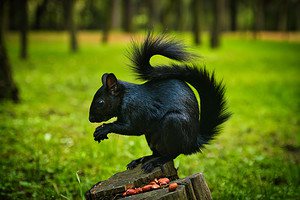Have you ever seen two squirrels chase each other around a tree? Maybe you’ve been at a local park and witnessed six or eight squirrels in a game of chase at the base of a tree or racing around a tree trunk like they’re tiny racecars. If so, this question likely popped into your mind: Why do squirrels chase each other?
It can be entertaining to watch a group of squirrels run around a tree or make their way up and down a tree trunk without stopping for a break. Well, you’ll be surprised to learn there are a variety of reasons why squirrels chase each other.
When you take some time to study the behavior of these small creatures, listen to the sounds they are making, and consider the current season of the year, you can determine the reason behind the chase.
Read the following information to learn about the chasing behavior of squirrels along with some other fun tidbits about these busy, adorable rodents.
Why Do Squirrels Chase Each Other?
One of the reasons squirrels chase each other has to do with establishing territory. Different species of squirrels have territories of varying sizes. One squirrel can establish a territory that includes a couple of acres while another has a territory of 25 acres.
It’s not so much the size of the territory, but the quality of the things contained in the territory. Squirrels look for areas with a large source of food and plenty of places to take shelter when foxes, hawks, and other predators enter the vicinity.
Generally, a male squirrel marks its territory with its urine. A lot of animals mark their territory with urine including deer, jaguars, chipmunks, bears, and domesticated dogs to name a few. A squirrel can also use the liquid from scent glands located around its mouth.
Additionally, in adult squirrels, chasing is most commonly related to maintaining or establishing dominance whish is how territorial disputes are settled among squirrel species. Along with exerting dominance. Chasing is seen in mating or play. Many young squirrels chase each other to socialize. This type of behavior is common in mammals and can be seen in dogs and cats.
The squirrel rubs its nose or face onto trees, grass, or wherever it wants to mark territory. They mark their territory to keep their food supply and shelter secure from other squirrels. All of these small mammals have an excellent sense of smell so they can detect the scent of another squirrel.
When you see two squirrels chasing each other it may be because one male has invaded the other male’s territory. Look closely and you’ll see they may be biting, nipping, or scratching each other as well. This sort of fight over territory can appear to be very violent.
Squirrels may also make screeching noises when in a fight for a territory to try to scare their opponent away. They can swiftly move all the way around a tree trunk, jump from branch to branch and even scamper across large areas of grass in this pursuit. Squirrels can fall out of trees in the midst of this fight. However, they are usually not hurt as a result of a fall.
Eventually, the squirrel that is defending its territory will cause the other one to move off. Or the squirrel that invaded the territory turns out to be dominant and takes the territory as its own. When it comes to these encounters, the strongest, most persistent squirrel wins out.

©iStock.com/virat sharma
Chasing During Mating Season
If you see two or more squirrels chasing each other between December and February or June and August, it likely has to do with mating season.
It’s not uncommon for more than one male to pursue a female that is ready to mate. The males chase each other in an effort to establish dominance and run the other males out of the area.
This sort of chase can go on for an hour or a few minutes depending on the strength of the males involved. The strongest male left after the chase is the one able to mate with the female.
A male squirrel may also chase a female during the mating process. The male may chase the female so closely that it has its nose right against the female’s back end. He is picking up her scent to make sure she is ready to mate. You may hear the male make a sound similar to the words muk-muk. This is an imitation of the sound that squirrel babies make. It is to encourage the female to mate.
Chasing to Protect a Food Supply
If you see two squirrels in a chase it may have something to do with food supply. As you know, squirrels spend a lot of time gathering acorns, fruit, and vegetation to store in their nest during the cold weather months. Foraging for food is a matter of life and death with many animals including squirrels. This store of food is a treasure that squirrels fiercely protect.
When there is a low supply of food in one area, it can lead to many of these chase scenes because the squirrels are fighting for survival. If they don’t have enough food stored away during the cold weather months these animals won’t be able to survive or feed their young.
When one squirrel gets too close to another’s nest and food supply, the nest’s owner takes off after the intruder to move it away. Nipping, biting, and screeching are all behaviors on display when a squirrel is protecting its food supply.

©iStock.com/Tntk
Chasing as a Form of Play
You’ll be glad to learn that not all squirrel chases have an aggressive tone. If you see several squirrels running around in the branches of trees or on the ground it may be a group of juvenile squirrels. They are likely to be brothers and sisters from the same litter.
Squirrel babies are born in the early springtime and the late summer. They won’t come out of the nest until they have a full coat of hair. Juvenile squirrels look like miniature versions of adult squirrels. Young squirrels aren’t able to live independently until they are 10 to 12 weeks old.
So, they are learning how to find food for about three months before they go off and build their own nest and raise a family.
Juvenile squirrels chase each other and may even appear to be fighting. This is done out of fun and to help them develop speed so they can survive as adult squirrels. If you see this group of squirrels staying close to the same tree and you see a nest in that tree, then they are probably juvenile squirrels from that nest playing a game of chase.
A Summary of Why Squirrels Chase Each Other
The bottom line is that squirrels chase each other for many different reasons. Sometimes they are exerting dominance or making the boundaries of their territory known to others. Other times they are playing with siblings or flirting during mating season. And lastly, some squirrels chase each other when there isn’t enough food or the population is too crowded.
Next Up…
- Are Squirrels Rodents? – Are squirrels just cousins to rats or mice? Find out now!
- Ground Squirrel Vs Tree Squirrel: What Are the Differences? – What are the main differences between a ground squirrel and a tree squirrel? Keep reading to learn!
- Squirrel Lifespan: How Long Do Squirrels Live? – How long do squirrels normally live for? Is it longer than a rat? Learn it all here!
The photo featured at the top of this post is © iStock.com/Gabriel Mash
FAQs (Frequently Asked Questions)
How many species of squirrels exist?
Biologists estimate there are over 200 species of squirrel. They exist on every continent with the exceptions of Antarctica and Australia.
Do all species of squirrels chase each other?
All squirrels chase each other, but some are less territorial than others. For example, gray squirrels are less territorial than many other species, but they will still chase another squirrel if necessary. Alternatively, red squirrels are known to be very territorial and won’t hesitate to chase any other squirrel away.
No matter how territorial, all squirrel species do whatever it takes to survive.
Do young squirrels chase old squirrels?
Yes. Squirrels can live from 3 to 7 years in the wild. This means that young squirrels often encounter much older ones. When it comes to a chase, the age of a squirrel doesn’t matter.
If an older squirrel that’s not strong or healthy invades the territory of a young squirrel, the young squirrel won’t hesitate to chase it away.
Can one squirrel seriously hurt another during a chase?
Though the fight between squirrels can look and sound really vicious, it doesn’t usually end in injuries for either one. The point of the fight is to drive the other squirrel away from the area. The fight is not meant to end in injury or death.
Is a squirrel a good pet?
A squirrel is not a good house pet. They are wild animals that need to be outside climbing in the trees with other squirrels.
Someone who sees a baby squirrel sitting on the ground near a tree may try to pick it up and take it home. Though the person has good intentions, this can be the wrong thing to do. The mother squirrel may come back for her missing baby and carry it back to the nest. Handling the baby squirrel can prevent its mother from retrieving it. The scent of a human’s hands on the baby can drive the mother away.
The best plan of action is to watch the baby squirrel from afar. If the baby is still sitting there after several hours, then contact a wildlife rehabilitator. This professional knows how to take proper care of a baby squirrel that’s been abandoned by its mother.
Thank you for reading! Have some feedback for us? Contact the AZ Animals editorial team.






